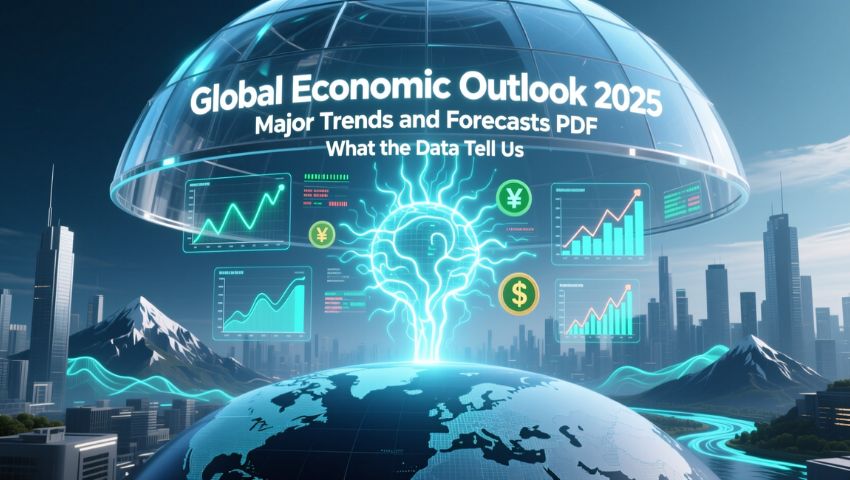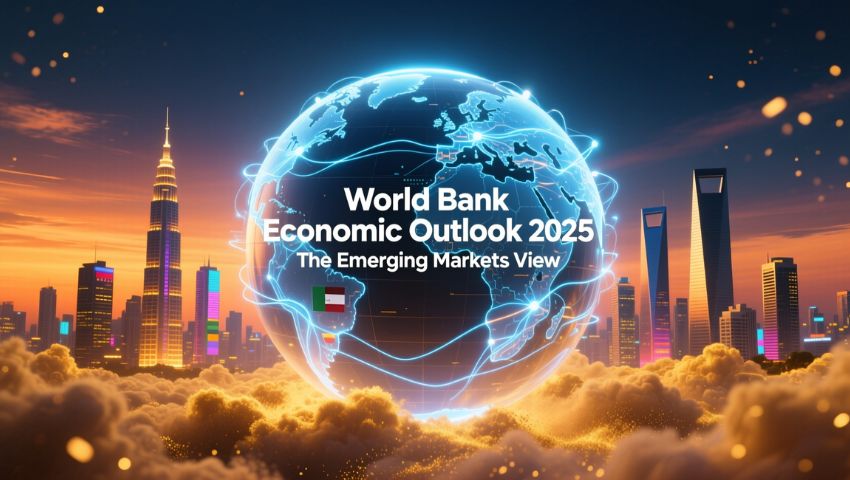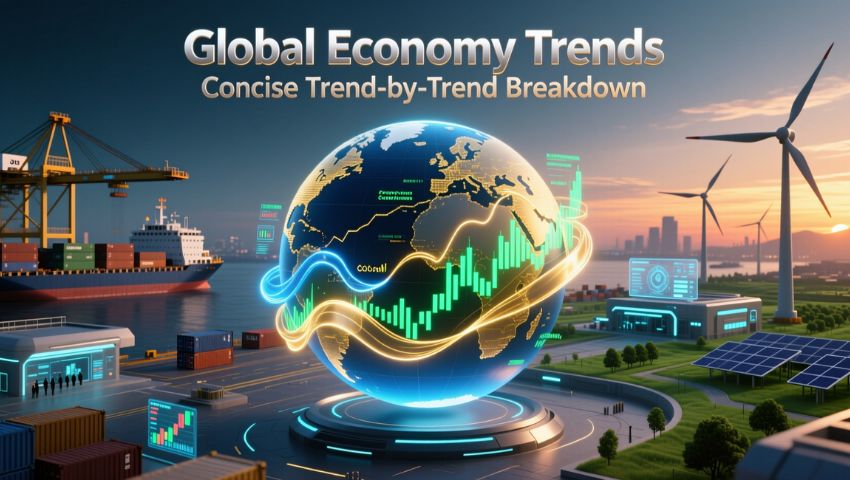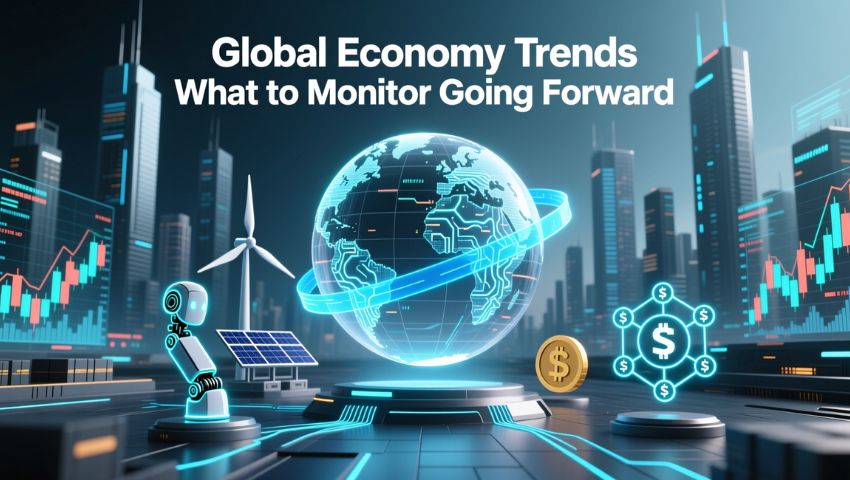The Global Economy Trends in 2025 stands at a turning point shaped by shifting trade policies, advancing technology and persistent inflation. As noted in the IMF World Economic Outlook 2025 global growth remains steady yet uncertain urging investors and policymakers to prepare for a changing economic future.
Rising tariffs, geopolitical tensions and uneven growth have reshaped global markets. The World Bank Economic Outlook 2025 and IMF Report 2025 point to widening gaps between regions while digital innovation and green energy redefine competition and collaboration across economies.
Imagine knowing tomorrow’s economy today that’s what Global Economy Trends 2025: Key Insights Shaping the Future delivers. Backed by data from the IMF World Economic Outlook January 2025 World Economic Outlook July 2025 and Global Economic Prospects World Bank it reveals the major forces shaping our financial future.
Quick Facts
| Key Area | Highlights 2025 | Insights / Impact |
|---|---|---|
| Global Growth Outlook | Global GDP expected to grow around 2.9%–3.1% | Moderate recovery led by Asia and developing economies |
| Inflation Trends | Inflation rates stabilizing but remain above pre-pandemic averages | Central banks maintain cautious monetary policies |
| Trade Dynamics | AI-driven investments and supply chain realignments boost short-term trade | Rising tariffs may slow trade momentum into 2026 |
| Finance & Investment | Over 90% of world trade linked to global finance networks | Monetary tightening increases capital market volatility |
| Emerging Markets (World Bank Outlook) | EMDEs face low growth and high debt challenges | Fiscal reforms and debt restructuring become priorities |
| Developed Economies (IMF Report) | U.S. and EU show slower but steady recovery | Focus on tech-led growth and reshoring manufacturing |
| Climate & Sustainability | Green investments expand, supported by policy incentives | Sustainability linked to future trade competitiveness |
| Policy Recommendations | Strengthen multilateral cooperation and fiscal resilience | Aim for inclusive, stable, and sustainable global growth |
Global Economic Outlook 2025 Major Trends and Forecasts PDF What the Data Tell Us

If you have ever downloaded economic reports and found them dense here’s the quick takeaway: Global growth is expected to slow significantly. According to the IMF’s July 2025 update global growth is projected at about 3.0 % for 2025 (and 3.1 % in 2026). (IMF) Meanwhile the World Bank’s “Global Economic Prospects” flags growth as low as 2.3 % under adverse scenarios. (World Bank)
Key highlights
- Growth deceleration: The world is entering a phase of lower-for-longer growth.
- Divergence among economies: Some countries will perform better, others worse.
- Trade and finance interplay: The links between global trade tariffs and finance are tighter than ever.
- Structural headwinds: Demographics productivity, climate risks all matter now.
- Technology as both disruptor and enabler: Especially artificial intelligence (AI).
Global Economy Trends Forecast for Next 5 Years What It Means for You
The next five years (2025-2030) will set the tone for a transformed global economy. The economic forecast for next 5 years isn’t about a rebound to the old “normal” of 4-5 % growth globally rather about adaptation.
- Growth is likely to hover around 3 % globally well below the historic 3.7 % (2000-19). (IMF)
- Inflation may ease overall but core inflation (ex-food & energy) remains sticky.
- Supply chains will remain under pressure influenced by geopolitics, trade friction and regionalisation.
- Countries with favourable demographics productivity gains and robust institutions will outperform.
- The digital-AI-green transition will be a dominant theme.
Anecdote: The family-run manufacturing business
Consider a medium sized manufacturing firm in Southeast Asia. They told me they used to plan in five year cycles. Now they revise plans every 12–18 months because “what we assumed would be stable is no longer so.” This is the mindset shift many need.
IMF World Economic Outlook January 2025 Early Signals and Revised Expectations
Earlier in the year the IMF’s January update forecast growth of 3.3 % for both 2025 and 2026. (IMF) Over time that was revised downward reflecting increased trade tensions, slower productivity growth and policy uncertainty. What this tells us is that forecasts are moving targets and so should your strategy.
Global Trends 2025 A Transformed World The Big Picture Structural Shifts
Beyond short term forecasts lie deeper trends that will define the decade. These are the global trends 2025 you need to keep front-of-mind.
- Demographic change: Aging populations in advanced economies, large youth bulges in some emerging markets.
- Climate and environment: Extreme weather transition costs infrastructure needs.
- Shifting globalisation: Supply chains are regionalising; trade liberalisation is stalling.
- Technology acceleration: AI automation data economies transforming industries.
- Policy fragmentation: Rising protectionism divergence between central banks shifting monetary regimes.
These trends don’t just matter; they shape which businesses win and which fall behind where investors place capital and how countries reform their economies.
Global Economy Trends July 2025 Mid Year Checkpoint
The July edition of the IMF’s World Economic Outlook reflects evolving conditions:
- Growth revised upward slightly from April (due to tariff front loading and fiscal support) to ~3.0 % for 2025. (IMF)
- But the improvement is fragile risks remain elevated (trade inflation geopolitics).
- The gap between emerging markets (≈4 % growth) and advanced economies (≈1.5 %) remains large.
Global Economy Trends 2025 PDF The Full Report and Data
The IMF World Economic Outlook 2025 PDF gives a comprehensive view of the global economy offering valuable insights for investors, researchers and policymakers. Inside you’ll find detailed country level data economic projections and policy recommendations shaping growth and inflation trends for the coming years.
For analysts and practitioners the IMF report 2025 serves as a practical tool. It includes downloadable datasets and models to create dashboards and forecast scenarios. Whether assessing the global economic outlook 2025 or planning future strategies this report remains a vital reference for evidence based decisions.
World Bank Economic Outlook 2025 The Emerging Markets View

The World Bank Economic Outlook 2025 provides crucial insights into the performance of emerging markets and developing economies (EMDEs). According to the Global Economic Prospects 2025 report global growth is projected to hover around 2.3% in downside scenarios reflecting persistent challenges such as trade barriers and high borrowing costs.
The report highlights how low growth and rising debt levels are putting pressure on fiscal stability across many developing nations. For policymakers and investors the World Bank’s analysis serves as a vital guide to understanding the vulnerabilities and opportunities shaping the global economic outlook 2025.
Step-by-Step Guide How to Use These Insights
Here’s a practical path you can follow:
Clarify your position
- Are you a business leader, investor , policy maker or individual?
- In which geographies and sectors are you active?
- What assumptions do you hold about growth inflation trade?
Map the key trends to your context
- For each major trend (growth slowdown inflation trade tech demographics) ask: How will this affect me or my domain?
- Example: A logistics company might focus on supply chain fragmentation and tariffs.
- Example: An investor may prioritise AI enabled firms or those in resilient emerging markets.
Assign actions and indicators
- Choose 2-3 actionable items from guides below.
- Select metrics to track (e.g. GDP growth rates tariff announcements inflation changes).
- Set review timelines (monthly quarterly).
Review & adjust
- At each review ask: Did the assumptions hold? Have the inputs changed?
- Adjust your strategy: allocate resources differently, hedge differently, change geographies.
Build both resilience and opportunity mode
- Resilience: Cash buffers diversified supply chains fixed rate debt.
- Opportunity mode: Invest in growth themes like AI green transition emerging markets with upside.
Global Economy Trends Why Invest or Buy with Confidence Now
You might be wondering: What product or service is this article nudging me toward? The answer: high quality insight that turns macro economic chaos into actionable strategy. Here’s why you can buy with confidence:
- It is informed by trusted institutions (IMF World Bank) and updated datasets.
- It offers step-by-step operational guidance not just charts and numbers.
- It highlights emerging winners not just risks.
- It helps you mitigate downside while positioning for upside.
In other words: when the world is changing quickly having clear well designed insight isn’t a luxury it’s a necessity.
Global Economy Trends Concise Trend-by-Trend Breakdown

Slowing Growth & Economic Divergence
Global growth is decelerating; some estimates show ~3.0 % in 2025 from ~3.3 % in 2024. (IMF) Meanwhile the gap between advanced and emerging economies widens: advanced ~1.4-2 % emerging ~4 %+. (IMF) Why it matters: Resources talent investment will flow toward stronger growth zones. What you can do: Review region exposure and diversify into higher growth markets.
Easing Inflation but Sticky Pressures
Headline inflation is falling but core inflation (services wages) remains stubborn. Central banks may act cautiously. Why it matters: Cost structures and consumer behaviour adjust slowly. What you can do: Lock in input costs, invest in higher margin segments and monitor wage pressures.
Trade Tariffs & Supply Chain Reshaping
Trade liberalisation is under pressure. The cost of doing business globally is rising with tariffs, logistics delays and geopolitical friction. (IMF) Why it matters: Higher cost of goods, more risk in global sourcing. What you can do: Map supply chains, diversify sourcing and build flexibility into design.
Demographic & Environmental Headwinds
Aging populations and climate risks are increasingly structural constraints. The cost of adaptation healthcare pensions and infrastructure is rising. (Open Knowledge Repository) Why it matters: Labour scarcity, rising insurance costs, fiscal pressure. What you can do: Invest in productivity automation resilience planning.
Technology Acceleration & AI Imperative
The rise of AI and automation is not just hype, it’s reshaping industries and jobs. Experts compare its potential impact to electricity or the steam engine. Why it matters: Competitive advantages will shift to those who adapt. What you can do: Embrace tech upgrades, train workforce partners with AI providers.
Policy Uncertainty & Financial Fragility
Monetary policy divergence, rising public debt and policy swings increase risk. For example the IMF warned of widening global current account imbalances. (Reuters) Why it matters: Investment risk makes financial shocks more likely. What you can do: Build financial resilience, hedge risk, maintain liquidity.
Emerging Markets Debt & Developing Economies
Emerging economies face the dual challenge of slow growth and rising debt costs. The World Bank notes these economies are now more vulnerable than before. (The World Bank Documents) Why it matters: Opportunity exists but risk is high. What you can do: Focus on countries with strong fundamentals and use local partnerships wary of debt/FX risk.
Global Economy Trends Real World Anecdotes
- A small retailer in Southeast Asia said last year’s shipment delay wasn’t just a hiccup it caused a full rethink of their business model. They now hold more inventory and source from 3 countries instead of 1.
- A family owned manufacturing plant told me: “We used to plan five years ahead. Now we revise every 12-18 months.” They have added automation, cut redundant roles and diversified customers.
- A marketing agency in the US adopted generative AI for copywriting reduced manual hours by 30 % and then reoriented their business model toward strategy rather than production.
These stories illustrate two points: (1) the pace of change is faster; (2) adaptability is becoming the key competitive advantage.
Global Economy Trends What to Monitor Going Forward

Keep an eye on these signals:
- Tariff announcements: New trade barriers often trigger chain reaction effects.
- Central bank decisions: A surprise rate hike or slow cut changes borrowing costs and valuations.
- Major climate events: A catastrophic weather event can disrupt supply chains and regional growth.
- Technology regulation: AI and data regulation are evolving quickly and may shift advantage.
- Emerging market defaults or crises: A shock here can ripple globally.
- Consumer confidence drops: When households pull back spending and investment fall.
Common Mistakes to Avoid
- Assuming “steady growth” returns: The old baseline is gone except lower growth and more volatility.
- Treating all regions the same: Growth and risk diverge sharply by customising strategy.
- Ignoring trade/supply chain risk: Even small supply disruptions can cost more than anticipated.
- Thinking tech is optional: In 2025-30 tech will separate winners from the rest.
- Waiting to act: The “window of opportunity” may move quickly early movers matter.
Frequently Asked Questions
Q1: Is a global recession inevitable?
No. Current forecasts by the IMF and World Bank show growth in 2025 albeit modest (~3 %). (IMF)
Q2: Should I pause investing until things clear up?
Not necessarily. Slower growth means shifting opportunities, not no opportunities. With smart strategy you can gain an edge.
Q3: Is inflation no longer a concern?
Inflation is easing but core inflation remains a concern so cost pressures and rate risks persist.
Q4: Which sectors will do best?
Tech/AI resilient supply chains high productivity services regions with favourable demographics.
Q5: What’s the most important mindset change?
Adaptability. Planning for change not assuming continuity. Scenario thinking becomes essential.
Conclusion
As we step further into 2025 the global economy trends highlight a world in transformation. The insights from the IMF World Economic Outlook 2025 and World Bank Economic Outlook 2025 reveal both progress and persistent challenges from slowing growth in advanced economies to emerging opportunities in developing markets. Policymakers and investors alike must focus on adaptability, innovation and collaboration to sustain long term resilience.
Looking ahead, the Global Economic Outlook 2025 underscores the importance of digital transformation, sustainable energy and fair trade as pillars for growth. By aligning strategies with these key insights nations and businesses can better navigate uncertainty and unlock inclusive prosperity. The coming years will test our global cooperation but they also hold the potential for a stronger more connected economic future.

Hi, I’m John J. Carney, the admin and founder of Hub Finance Spot. I created this platform to make finance, business, and investment topics easier to understand for everyone. Over the years, I’ve gained experience in personal finance, business development, and market analysis. My goal is to share practical and reliable information that helps readers make informed financial decisions. At Hub Finance Spot, I focus on creating content that’s simple, clear, and based on real insights so you can trust what you read.